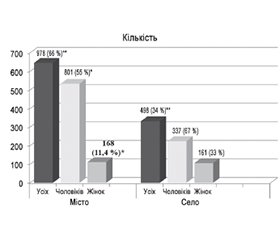Международный неврологический журнал Том 20, №4, 2024
Вернуться к номеру
Госпітальна оцінка тютюнокуріння як одного із факторів ризику інсульту серед стаціонарних хворих за даними 15-річного дослідження (огляд літератури та власні дослідження)
Авторы: Онопрієнко О.П. (1), Тріщинська М.А. (2), Цуй Цзінь Шень (Cui Jingsheng) (1), Цуй Юнь Кай (Cui Yun Kai) (1)
(1) - КНП «Броварська багатопрофільна клінічна лікарня», м. Бровари, Київська область, Україна
(2) - Національний університет охорони здоров’я України імені П.Л. Шупика, м. Київ, Україна
Рубрики: Неврология
Разделы: Клинические исследования
Версия для печати
Актуальність. У статті наведені світові наукові докази щодо тютюнокуріння як одного з факторів ризику (ФР) мозкового інсульту (МІ). За даними ВООЗ, від захворювань, пов’язаних з курінням, щорічно помирає 4 млн людей у світі. Прогноз до 2025 року невтішний, щорічно втрати будуть становити вже 10 млн осіб. В Україні понад 9 млн активних курців серед працездатного населення. Усе це спонукало нас до проспективного дослідження одного із вагомих факторів ризику інсульту. Мета: науково обґрунтувати фактори МІ, визначити нікотинову залежність серед госпіталізованих пацієнтів з МІ різного віку, статі, міського та сільського населення з метою профілактики МІ. Матеріали та методи. Використано такі методи: бібліосемантичний, епідеміологічний метод, прагматичний підхід, включно з клініко-неврологічним, лабораторним, нейровізуалізаційним методами, а також медико-соціологічний метод. В ангіоневрологічному відділенні КНП «Броварська БКЛ» проведено прагматичне проспективне дослідження за 15-річний період з 2007 по 2022 р. — 9527 хворих, що перенесли церебральний інсульт. Проводили тестування хворих на МІ та їх близьких на предмет нікотинової залежності (НЗ) за Фагерстремом. Результати. За даними нашого 15-річного дослідження, у хворих з МІ міста Бровари серед чоловіків НЗ відмічено у 54,6 % при стандартизованому показнику для чоловіків міста 45 %. Тоді як серед жінок у нас відповідно 12 проти 20 % за стандартизованим показником, тобто у місті серед жінок з МІ менша НЗ на 8 % (р < 0,001). Серед чоловіків з МІ із сільської місцевості маємо 23 % при стандартному показнику 63 %, а у жінок з МІ із села НЗ виявили в 11 % при стандартному показнику 8 %, тобто цей ФР МІ у чоловіків із села менш імовірний на 36 % проти стандартизованого показника (63 %), а серед жінок вищий на 3 % (p < 0,05). Але у цілому у старечому віці НЗ становить 92 % у чоловіків, а у жінок — 8 % (р < 0,001). Висновки. Встановлена залежність між відносним ризиком розвитку ішемічного інсульту й кількістю викурюваних сигарет, стажем тютюнокуріння (ТК), а також виявлено менший ризик для жінок порівняно з чоловіками. Отримані дані щодо ТК дещо не збігаються зі стандартизованими показниками для міського та сільського населення за гендерною ознакою: у чоловіків із села ТК було меншим майже наполовину від стандартизованого показника, а серед жінок із села з МІ — більшим ніж на 3 %. Необхідне проведення подальших досліджень ФР інсульту для вчасного виявлення модифікованих факторів, запобігання їм серед догоспітальної популяції та подальшої мінімізації судинної патології мозку, а також профілактичного запобігання шляхом лікування цієї категорії людей.
Background. The article presents global scientific evidence regarding smoking as one of the risk factors of cerebral stroke (CS). According to the World Health Organization, 4 million people worldwide die annually from smoking-related diseases. The forecast until 2025 is disappointing, annual losses will already amount to 10 million people. In Ukraine, there are more than 9 million active smokers among the working population. All this prompted us to conduct a prospective study on one of the significant risk factors for stroke. Objective: to scientifically substantiate the factors of CS, to determine nicotine dependence (ND) among hospitalized patients with CS of different ages, sexes, urban and rural population with the aim of CS prevention. Materials and methods. The following methods were used: bibliosemantic, epidemiological method, pragmatic approach, including clinical neurological, laboratory, neuroimaging methods, as well as the medical sociological method. At the angioneurological department of the Communal Non-Commercial Enterprise “Brovary Multidisciplinary Clinical Hospital”, a pragmatic prospective study was conducted for the 15-year period (from 2007 to 2022) with participation of 9,527 patients who suffered a cerebral stroke. Patients with CS and their relatives were examined for ND using the Fagerström test. Results. Accor-ding to the data of our study, among patients with CS from Brovary, ND was detected in 54.6 % men, with a standardized indicator for men in the city of 45 %. Among women, this indicator was 12 vs. 20 % according to a standardized indicator, i.e. in the city, ND in women with CS is lower by 8 % (p < 0.001). Among men with CS from rural areas, we have 23 % with a standardized indicator of 63 %, and among women with CS from rural areas, ND was detected in 11 % with a standardized indicator of 8 %. That is, this risk factor of CS in men from rural areas is 36 % less likely against a standardized indicator (63 %), and among women, it is higher by 3 % (p < 0.05). But in general, in old age, ND is 92 % in men, and 8 % in women (p < 0.001). Conclusions. The relationship was found between the relative risk of developing an ischemic stroke and the number of cigarettes smoked, duration of smoking, and a lower risk was detected for women compared to men. The obtained data on duration of smoking do not coincide with the standardized indicators for the urban and rural population by gender: in men from the villages, duration of smoking was less than half of a standardized indicator, and among women from the villages with CS, by more than 3 %. Further research is needed on the risk factors of stroke for the timely identification of modifiable factors, their prevention among the pre-hospital population and further minimization of cerebrovascular pathology, as well as prevention through the treatment of this category of people.
тютюнокуріння; фактори ризику інсульту; тест Фагерстрема; нікотинова залежність; лікування; аурикулорефлексотерапія; есциталопрам; Циклокс.
tobacco smoking; stroke risk factors; Fagerström test; nicotine dependence; treatment; auriculoreflexotherapy; escitalopram; Ciklox

